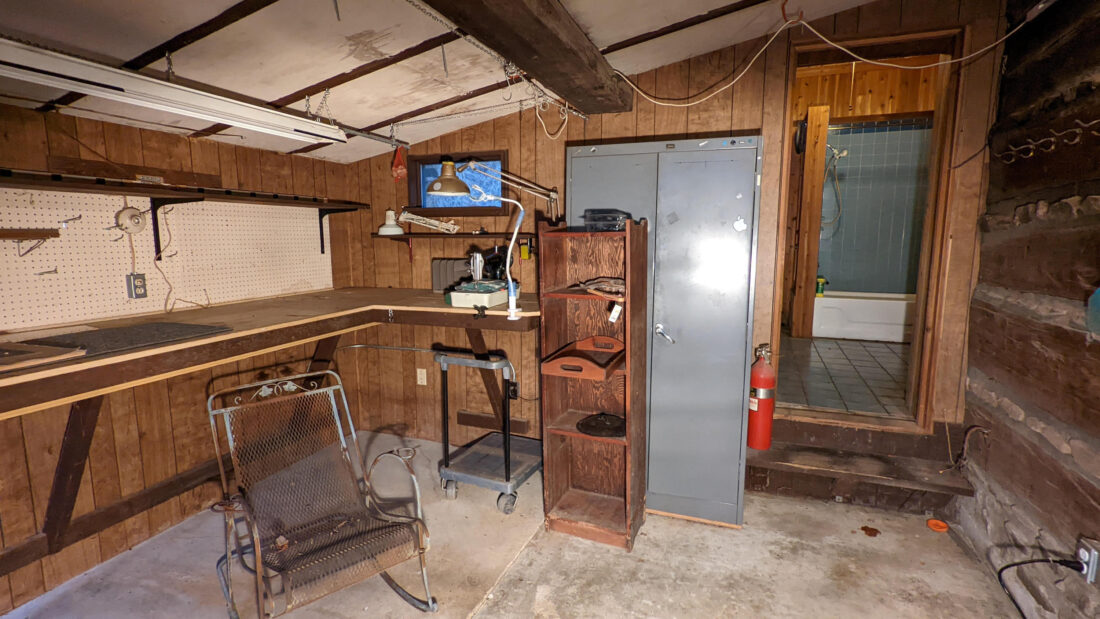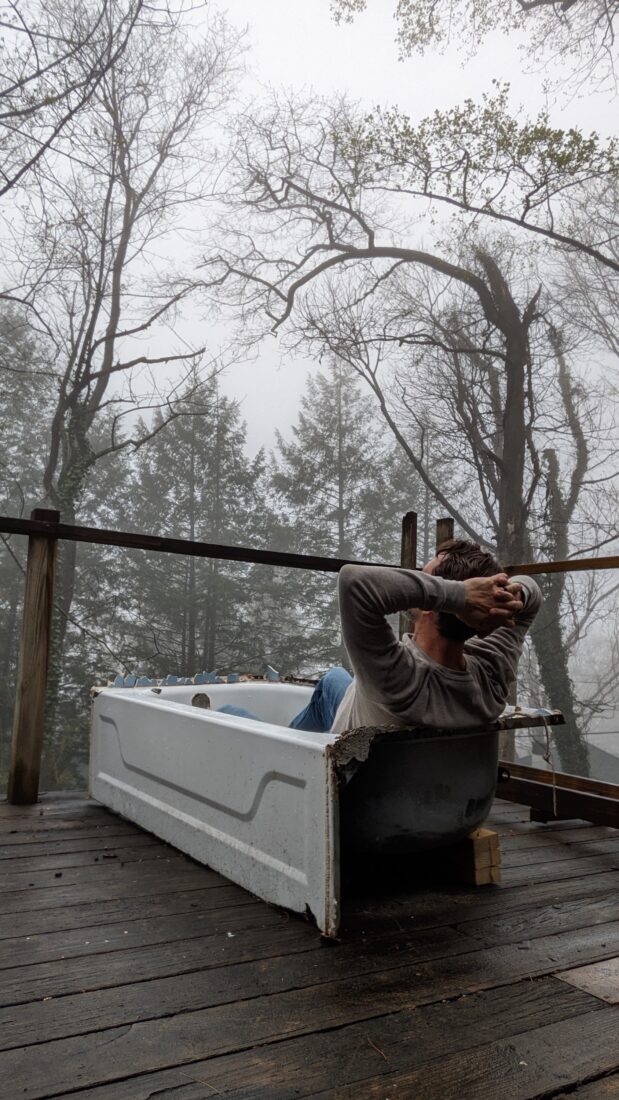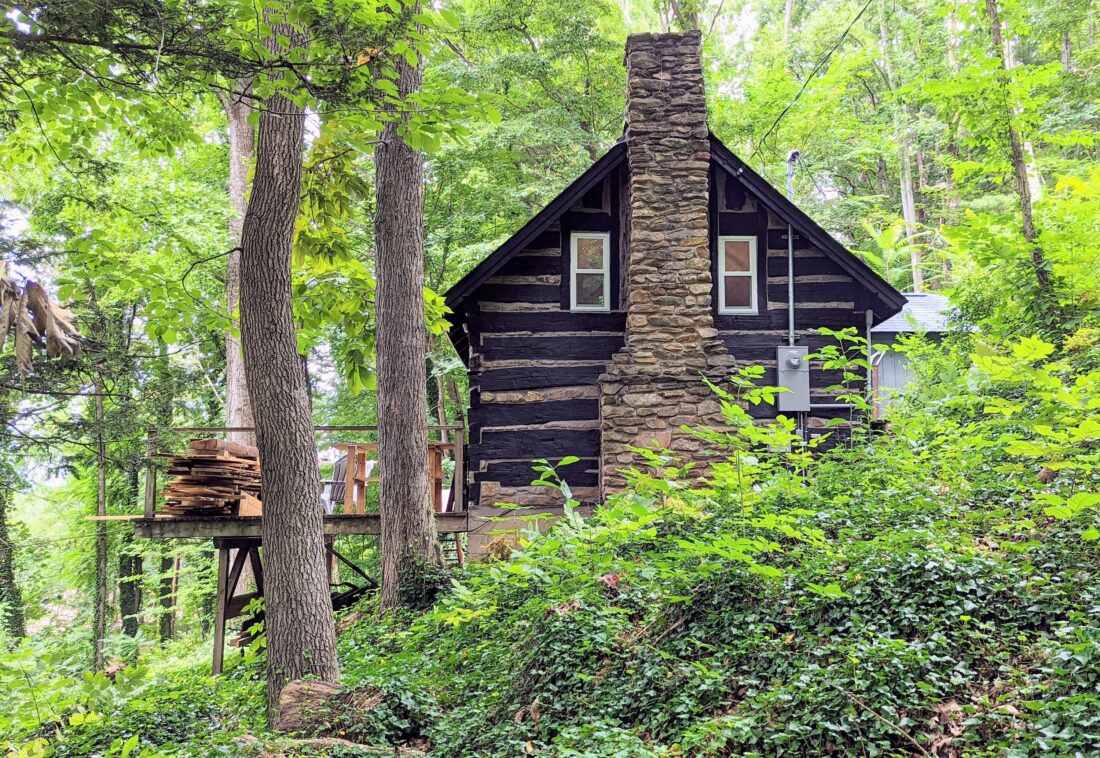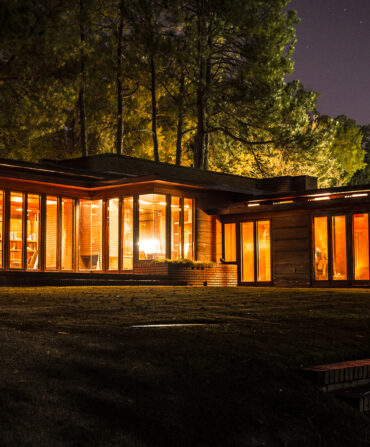There I stood, in my “dream cabin,” freezing on a late winter morning, balancing on a stack of boxes as bulky as a loveseat. The cardboard shifted beneath me. As I raised the shovel, my palms sweated against the wooden handle. Construction workers peered in through the window. No way they were coming back in. Not until the six-foot snake was gone.
Moments like this, when I’ve got one shot at an athletically difficult maneuver, aren’t exactly a strength for me, a man just shy of his fiftieth birthday who picked daisies in left field in Little League.
The workers found the snake that morning. I called a wrangler first. His next opening was six weeks out, but he walked me through options. Black racers eat rodents, so catch and release it if you’re brave. Thing is, he warned me, a racer’s non-venomous bite hurts like hell. Killing the thing would bring me no pleasure, but fighting it into a pillowcase sounded like foolishness.
I’d have one strike, one quick shot with the metal edge. As I raised the shovel higher, I heard a crack from the boxes below.
The snake became one of many unpredictable, sometimes downright disastrous moments that struck while redoing my timber cabin perched on the side of a cliff in Asheville, North Carolina. Sometimes it felt like the whole house might tumble down the incline, and some days I would’ve been thrilled to find it in a heap down on Charlotte Street.
But renovating the old place also brought a series of small triumphs. A writer with no formal construction experience, I did most of the work myself, leaning hard on internet videos and advice from friends and city inspectors. Should you try your hand at fixing an old cabin too? Or should this be a cautionary tale? Let’s assume, before I explain more, you don’t have high blood pressure.
The idea for this project came years earlier when my wife and I walked off the Art Loeb Trail in the Western North Carolina woods and met a guy from Gainesville, Florida. He explained that he had sold his house and bought a condo, and then purchased a second place in the mountains. That’s what we’ll do too, my wife and I decided on the drive to White Duck Taco Shop. In 2019, we traded our home near the New River in Fort Lauderdale for a Miami condo and banked a little cash for that place in the woods. We’d be snowbirds, in our forties.
Then the pandemic turned Asheville into a place where realtors could pay their kid’s Ivy League tuition off a single commission. Priced out, the second part of our plan seemed doomed.
We obsessed over new listings. We lost a bidding war on a log home the size of a storage shed. We decided to pass on the quirky modern spot with a front door that opened into a bathroom. Then the cabin popped up on the MLS after its third sale fell through. The math seemed hard to believe: a home on the side of Sunset Mountain, a mile from the Grove Park Inn, for under $300,000. I took a college buddy with me for the walk-through, and he couldn’t stop laughing. Our realtor joined him. Light streamed in from a thousand holes. A crack in the foundation split the bedroom into a funhouse. An electrical panel in the bathroom spoke of potential disasters. “It’s more of a camp than a house,” my wife said. We closed on it six weeks later.
Its story began sometime in the late 1800s, when it was just a ten-by-twenty-foot cabin with a peaked roof. A neighbor told me it started life a county over before being reassembled here. Somebody else added two additions—a small bedroom and bath—maybe a half century ago, bringing the total up to about six hundred square feet. Neighbors told me a hermit occupied it for a generation, with only a fireplace for heat and rodent roommates in the walls.

Our plan: I’d go part-time with my freelance writing and take my time redoing it. The insurance company had other plans. We’d need to update the electrical and add heating or we’d lose our provisional coverage. One month, they gave us. It felt like we were on a reality television show. My wife took to saying, “The producers will love this drama.”
Before the electricians could start, I’d need to demo everything, in a hurry. Then I’d install a mini-split to provide heat. Maybe then we’d find where all that water was seeping in. The demolition brought surprises. I opened the walls and discovered stores of acorns left by some critter. Long snakeskins draped between rafters, clear and ghostly.
We put up a Craigslist ad for anyone willing to haul off nearly everything inside: the rust-bucket metal sink cabinet, the coffin of a fridge, the Nixon-era stove. The two guys who showed up first were pushing seventy, beer-bellied and out of breath from the two flights of stairs that led to the street above. Piece by piece, they strapped the junk to a dolly and began the backbreaking climb, taking regular breaks for Marlboro Reds. Those two taught me something about mountainside labor: It’s about pacing, and it’s a marathon, not a sprint.
By late afternoon, they got to the fireplace insert, a beast of iron and soot. The stairs just might have collapsed beneath it, so I cut a hole in the deck’s rickety railing. An ivy-covered slope twenty feet below descended quickly to a narrow street. We maneuvered the hunk of metal to the edge and unstrapped the ties holding it to the dolly. We pushed it off.
The first hit sounded like a car wreck. Then the stove picked up speed, tumbling and losing pieces. It crashed mercifully into a maple tree, where I dislodged it with a two-by-four. It took all three of us to hoist it into the trailer.
With the demo mostly done a week later, the plumbers began. Their mantra: “We’ve discovered a problem.” And so they replaced everything, right down to jack-hammering the concrete foundation of the bathroom to run lines. A friend walked in and gave the reassuring assessment, “It looks like a crime scene.”
The downright speedy electricians finished in two weeks. A friend helped with the DIY mini split system, and with the insurance company satisfied, I could slow down. That meant solving more serious problems. It was March, and I could feel winter air passing through the holes between the century-old timbers. YouTube videos explained how to fill them with a masonry that stretches as the wood contracts on cold winter mornings. Days, weeks, months—maybe the rest of my life, it felt like some days—I filled those holes with the aid of a trowel and paper towels and blue vinyl gloves and hot herbal tea.
Every day, I’d find a new leak. Half the place was cut into the cliff, so I began by digging out the dirt against the timbers. I smeared concrete patch into a gap where wood meets foundation. I thought I had found every hole. Then I pressure-washed the exterior, and the inside looked like we’d left the windows down in a car wash.
By May, three months in, I got busy with a podcast project, and I needed help on the house. My wife started calling contractors to finish the bathroom. Most of them didn’t even get out of their trucks after they saw it from the street. We hired the one who seemed unfazed by the crime scene.
From our rental house across town, I was setting up an interview for the podcast one morning when the bathroom workers called. The three burly men were very much afraid of snakes. I found the black racer curled in the corner. I’d likely trapped it inside with my hole-patching. Standing on the boxes, hearing the crack I’d learn later was a sheet of cabinet backing, I tried not to consider what would happen if I missed. I brought the shovel down hard, and the metal edge shrieked against the concrete floor. One strike. One lucky strike.
Holes filled and previous residents evicted, I could start on the good stuff, the beautification. I stained timbers. I whitewashed inside to lighten the dark living room and went with black outside to cover up a century of mistreatment. My wife joined me one Saturday morning to fix the floor, me mixing and dumping out five-gallon buckets of a watery concrete leveler as she hurriedly spread it with a rake.
Following a chalk line one morning, I cut a twelve-foot hole the entire length of one bedroom wall so that whenever our windows arrived, we’d have a panoramic view of the mountains. The city inspector shook his head. “I’m sorry to do this,” he said, handing me a red card like I’d tackled a guy on a soccer pitch. The bedroom had a beam, an ancient timber weighing hundreds of pounds, running across the ceiling. That beam could crush the window, he figured. I stared out that big hole in the wall, wondering if the two-thousand-dollar window we’d already paid for would be going to the transfer station.
A structural engineer, a friend-of-a-friend, agreed to come by. He looked at the beam, the walls, and the ceiling before asking: “Got a chainsaw?” We attacked the beam with the Sawzall I had abused during the demo. The room filled with smoke as the dull blade struggled through ancient wood. It came down in a cacophony, a dull thud against concrete. The inspector nodded his approval days later, handing over a green card. My wife taped it to the wall.
Flooring was next, and I was prepping for the install one afternoon when the delivery company called. There’d been an accident. I found the box truck a half mile away, cordoned off by police tape. The driver had just finished giving his statement, and he was standing in the street, taking deep breaths. He explained that he had begun to make the steep Cherokee Road switch-back when the brakes quit. He careened backward, picking up speed. The truck began jack-knifing, and a front wheel flew off. A low brick wall mercifully caught the cab. It hung there, partially above a ravine. I asked the cop if I could unload my flooring. He made a good point: the weight of the boxes might be the only thing keeping the truck from plummeting into the crevasse.

The flooring finally arrived a week later and then, finally, the continually delayed windows. One summer day, while taking a break from the flooring install, my wife and I watched as two men hoisted our twelve-foot window. We danced when it fit.
Little details came together. My wife scrubbed the fieldstone fireplace. We gave ourselves three days of sore necks installing shiplap ceilings. I sourced hand-hewn wavy pine from a sawmill and covered the additions in a siding that matched the timbers, stuffing fieldstones in the masonry to continue the look from the original structure. Piece by piece, I removed two-by-sixes that once served as a janky sleeping loft above the kitchen, and the place filled with light like a tent revival. And then the contents of those boxes, unpacked and assembled, became a modern kitchen with a baby-blue fridge.
We moved in at the end of July. The bathroom guys had just finished, and the final product felt spa-like, modern for an old home. There are touches like a lighted vanity mirror, glass shower enclosure, hot water, heat, and an electrical system that isn’t a firefighter’s nightmare.

One afternoon I was carrying scrap wood up to the street—another task that made that whole summer feel like one long CrossFit workout—when three women pulled up. “I used to live here,” one of them said. It was the 1970s, and she was in her early twenties, crashing with her boyfriend. They’d huddle under a mound of blankets at night and dart to the fireplace every morning. The bathroom was also the kitchen back then, and she’d make coffee as she sat to pee. She got teary remembering worry-free days and blind love and lying on the roof to look up at stars between the maples.
She told me another piece of its story, how the cabin was once “the poor house” in Maggie Valley. The bankrupt would live in it to work off debts on a farm. One of the neighbors bought it a century ago and had it reassembled on the mountain as a playhouse for their kids. Before she drove off, she said: “I hope you love it like we did.”
Fall arrived soon. Black walnuts drummed the roof, and the maples went bare. We’d passed our final inspection. Not one leak in weeks. We lit our first fire. Cozy is a word we use a lot. Snakes and truck crashes and so many holes between the timbers feel not too far behind us. And we have a cabin in the woods.








